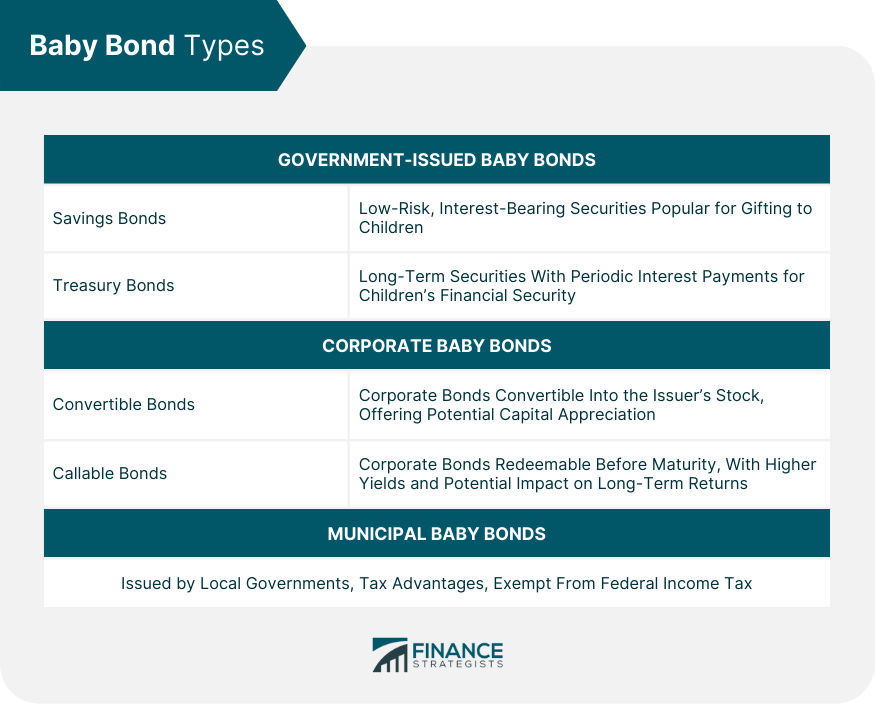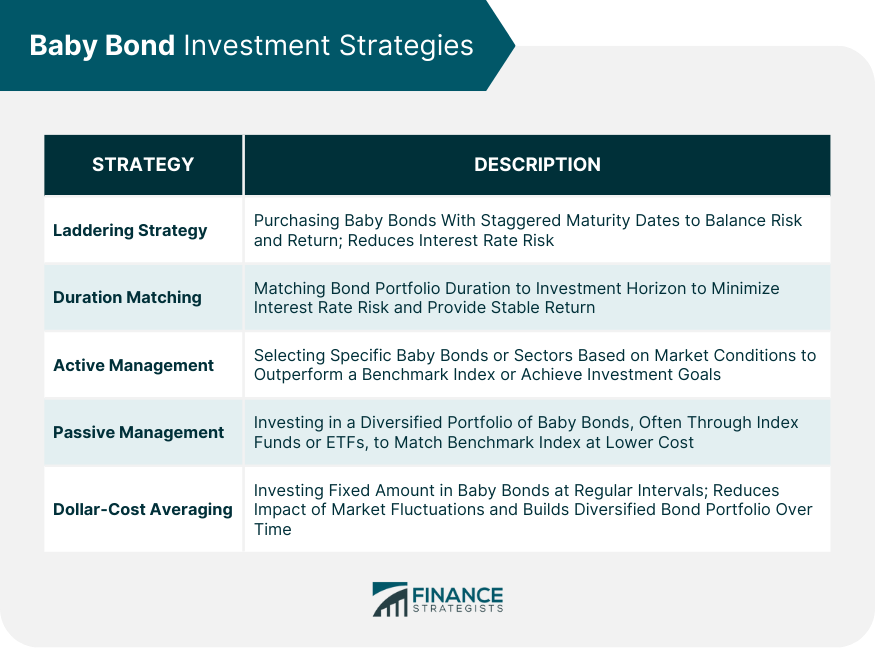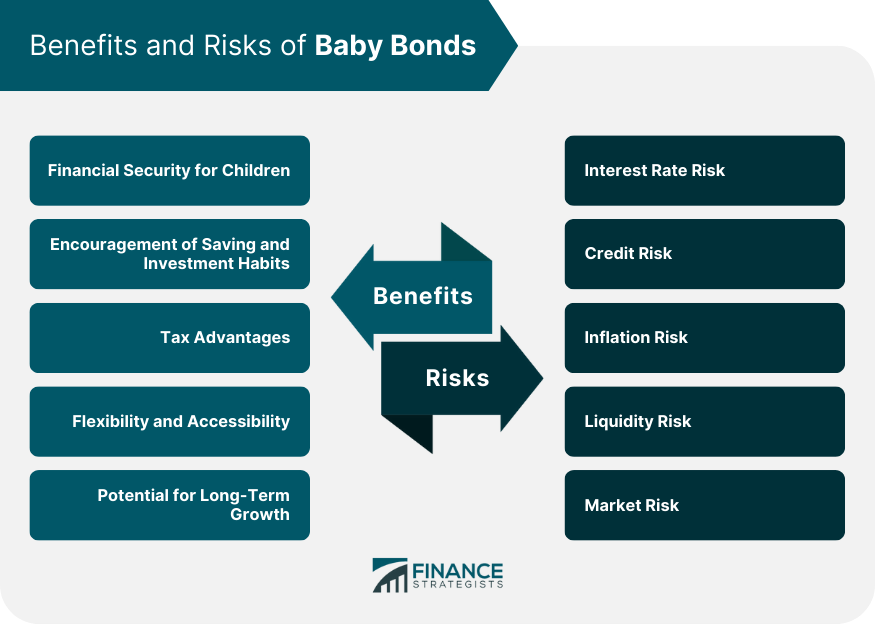A baby bond is a relatively small-denomination bond issued by governments, corporations, or municipalities to make investing more accessible for individual investors, particularly for the purpose of securing a child's financial future. Baby bonds aim to provide a long-term investment vehicle to secure children's financial future, support education, and reduce wealth inequality. They encourage saving habits and financial planning from an early age. Baby bonds have a rich history dating back to the early 20th century when the U.S. government issued small denomination bonds to encourage widespread investment among citizens. Over time, baby bonds have evolved to meet the changing financial needs of the populace. Government-issued baby bonds are backed by the full faith and credit of the government, making them a relatively safe investment option. Savings bonds are low-risk, interest-bearing securities issued by governments that accrue interest over a specified period. They are popular for gifting to children due to their safety and ease of purchase. Treasury bonds are long-term securities issued by the government with maturity periods of 20-30 years. They offer periodic interest payments and are popular as long-term investments for children's financial security. Corporate baby bonds are issued by corporations to raise capital and are subject to the company's creditworthiness. Convertible bonds are corporate bonds that can be converted into a predetermined number of shares of the issuing company's stock. They offer investors the potential for capital appreciation if the company's stock performs well. Callable bonds are corporate bonds that can be redeemed by the issuer before the maturity date. They offer higher yields to compensate for the risk of early redemption, which could impact the long-term returns for investors. Municipal baby bonds are issued by local governments and other public entities to fund public projects. They offer tax advantages, such as being exempt from federal income tax, making them attractive to investors in high tax brackets. A laddering strategy involves purchasing a series of baby bonds with staggered maturity dates to balance risk and return. This approach provides regular cash flow from maturing bonds and reduces the impact of interest rate risk on the portfolio. Duration matching is a strategy where investors match the duration of their bond portfolio to their investment horizon. This can help minimize the impact of interest rate risk and provide a more stable return on investment. Active management involves selecting specific baby bonds or sectors to invest in based on market conditions or other factors. This approach aims to outperform a benchmark index or achieve specific investment goals. Passive management involves investing in a diversified portfolio of baby bonds, often through bond index funds or ETFs, with minimal intervention. This strategy aims to match the performance of a benchmark index at a lower cost. Dollar-cost averaging involves investing a fixed amount in baby bonds at regular intervals, regardless of market conditions. This strategy reduces the impact of market fluctuations and helps investors build a diversified bond portfolio over time. Baby bonds provide a long-term investment vehicle that can help secure a child's financial future. They can be used for education, home purchases, or other major life expenses. Investing in baby bonds instills good saving and investment habits, teaching the value of long-term planning and financial responsibility from a young age. Baby bonds, especially those issued by the government or municipalities, often come with tax advantages. This can include tax-deferred growth, tax-free interest, or other tax exemptions. Baby bonds offer a range of investment options and maturity periods, making them flexible and accessible investment vehicles suitable for various financial goals. Baby bonds have the potential for long-term growth, allowing investors to capitalize on the power of compound interest over an extended period. Interest rate risk refers to the potential for bond prices to decline when interest rates rise. This can adversely affect the value of baby bonds, particularly those with longer maturities. Credit risk is the risk that the bond issuer may default on their interest payments or fail to repay the principal. This risk is higher for corporate and municipal baby bonds compared to government-issued bonds. Inflation risk is the potential for the purchasing power of the bond's interest payments and principal to be eroded over time due to rising prices. This can reduce the real return on investment and negatively impact long-term financial goals. Liquidity risk refers to the potential difficulty in selling a bond before its maturity date without incurring a significant loss. Baby bonds, particularly those with longer maturities or lower credit ratings, may have limited liquidity in the secondary market. Market risk is the potential for bond prices to fluctuate due to changing economic conditions or other external factors. Baby bonds, like all investments, are subject to market risk, which can impact their value and returns. US savings bonds are government-issued securities that accrue interest over time and are popular for gifting to children. They offer a safe and accessible investment option for individual investors. US Treasury bonds are long-term government securities that pay periodic interest and have a reputation for safety and reliability. They are popular for long-term financial planning, particularly for children's education and future expenses. Child Trust Funds (CTFs) were tax-free savings accounts introduced in the UK to encourage long-term savings for children. Although no longer available for new accounts, existing CTFs continue to provide a tax-advantaged investment option for children's future needs. Junior Individual Savings Accounts (JISAs) replaced CTFs in the UK and offer a tax-free savings option for children. They allow parents or guardians to invest in cash or stocks and shares on behalf of a child, with annual contribution limits. Many countries have implemented various programs and investment vehicles to promote long-term savings for children, such as Canada's Registered Education Savings Plans (RESPs) or Australia's Education Bonds. These programs often include tax incentives or government grants to encourage participation. Baby bonds serve as an accessible investment vehicle for individual investors, providing financial security for children and encouraging long-term savings habits. Various types of baby bonds, including government-issued, corporate, and municipal bonds, offer distinct benefits and risks. Investment strategies such as laddering, duration matching, and dollar-cost averaging can help manage these risks and achieve specific financial goals. Baby bonds play a crucial role in financial planning, providing a long-term investment option to secure a child's financial future. They promote financial literacy, encourage responsible saving habits, and contribute to reducing wealth inequality. As baby bonds continue to evolve and adapt to the changing financial landscape, investors are encouraged to further research and educate themselves on the benefits, risks, and investment strategies associated with these securities. Staying informed will help investors make the most of their baby bond investments and secure a brighter financial future for their children.What Is a Baby Bond?
Types of Baby Bonds
Government-Issued Baby Bonds
Savings Bonds
Treasury Bonds
Corporate Baby Bonds
Convertible Bonds
Callable Bonds
Municipal Baby Bonds

Baby Bond Investment Strategies
Laddering Strategy
Duration Matching
Active Management
Passive Management
Dollar-Cost Averaging

Benefits of Baby Bonds
Financial Security for Children
Encouragement of Saving and Investment Habits
Tax Advantages
Flexibility and Accessibility
Potential for Long-Term Growth
Risks and Limitations
Interest Rate Risk
Credit Risk
Inflation Risk
Liquidity Risk
Market Risk

Baby Bonds in Different Countries
United States
US Savings Bonds
US Treasury Bonds
United Kingdom
Child Trust Funds
Junior Individual Savings Accounts (JISAs)
Other Countries' Approaches
Final Thoughts
Baby Bond FAQs
A baby bond is a small-denomination bond issued by governments, corporations, or municipalities designed to make investing more accessible for individual investors, particularly for securing a child's financial future. They are important for long-term financial planning because they encourage saving habits, promote financial literacy, and provide financial security for children.
There are three main types of baby bonds: government-issued baby bonds (such as savings bonds and Treasury bonds), corporate baby bonds (such as convertible bonds and callable bonds), and municipal baby bonds. Each type offers distinct benefits and risks, making them suitable for various investment objectives.
Baby bond investment strategies, such as laddering, duration matching, and dollar-cost averaging, can help manage risks associated with interest rates, credit, inflation, liquidity, and market fluctuations. These strategies aim to balance risk and return, provide regular cash flow, minimize the impact of market volatility, and achieve specific financial goals.
In the United States, popular baby bonds include US savings bonds and US Treasury bonds, which are government-issued securities known for their safety and accessibility. In the United Kingdom, Child Trust Funds (CTFs) and Junior Individual Savings Accounts (JISAs) are popular tax-free savings options designed to encourage long-term savings for children.
Future trends and developments in the baby bond market include the digitalization of baby bonds through online platforms and mobile apps, increased focus on socially responsible investing, government initiatives to promote baby bond adoption, and evolving tax policies that may affect the tax advantages of baby bonds.
True Tamplin is a published author, public speaker, CEO of UpDigital, and founder of Finance Strategists.
True is a Certified Educator in Personal Finance (CEPF®), author of The Handy Financial Ratios Guide, a member of the Society for Advancing Business Editing and Writing, contributes to his financial education site, Finance Strategists, and has spoken to various financial communities such as the CFA Institute, as well as university students like his Alma mater, Biola University, where he received a bachelor of science in business and data analytics.
To learn more about True, visit his personal website or view his author profiles on Amazon, Nasdaq and Forbes.











